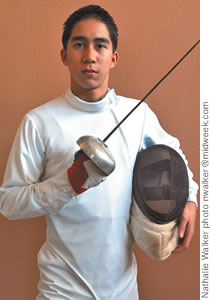Making A Point About Fencing

Wednesday - January 30, 2008
| Share
 Del.icio.us
Del.icio.us
|
Most of us, at some point in our lives, have enjoyed the swashbuckling movie scenes of actors like Errol Flynn or Douglas Fairbanks or Kevin Costner or Leonardo DiCaprio. We’ve witnessed the duels in Shakespeare’s great plays. To watch those valiant men duel- ing with swords or sabers, we’d often imagine ourselves in that role.
But few of us have actually followed through. One who did was young Roland Pendleton of Kailua.
“My favorite subject is history,” Pendleton says. “I remember reading about sword fighting. I watched movies like The Three Musketeers and King Arthur , saw it, and thought I’d try it.”
What Pendleton actually thought he would try at the age of 10 was the sport of fencing. Now, at age 17 and a senior at Kailua High School, Pendleton is the Hawaii state junior epee champion.
The epee is one of the three separate weapons in fencing - the other two are the foil and the sabre. Pendleton explains that the three distinct blades have different shapes. “The epee blade is shaped like a triangle,” he says. “The foil blade is shaped like rectangle. The saber is kind of a combination and is much heavier.”
Fencing dates back a few hundred years, at least, and is considered a so-called Western form of martial arts. Over the years, it has evolved from the swashbuckling and dueling that we’ve seen in the movies into an Olympic sport.
Pendleton practices his sport twice a week with members of the Hawaii Fencers Club. They meet in Honolulu at the Hongwanji Mission School.
Because of the inherent danger of working with blades - “I’ve been cut a few times, especially with the sabre,” Pendleton says - participants wear important safety equipment, including a fencing mask, a padded jacket and an underarm protector. Scoring is achieved by making blade contact with your opponent.
“There is an electronic button for safety, so it doesn’t penetrate,” he says.
According to the rules of fencing, the foil is a light and flexible weapon, developed in the the mid-17th century as a training weapon for the military. The target area in this discipline is restricted to the torso.
Like the foil, the epee also is a thrusting weapon. To score a valid hit, the fencer must fix the point of his weapon on his opponent’s target. However, the target areas covers the entire body and there are no rules about who can hit when.
The sabre is a so-called “cutting” weapon with which, Pendleton says, “you can slash and hit anywhere from the hips to the head.”
Pendleton credits his coach Antonio Nishimura along with his fellow club members for his success. Over the years, the Kailua native and son of former state Rep. David Pendleton and former Board of Education member Noemi Pendleton has participated at the Junior Olympics and the Summer Nationals.
“My best effort so far is in the Epee division,” he says. Pendleton showcased those skills by being ranked in the top 100 in the nation for his division age group. And most recently, he broadened his skills by venturing into so-called “Open” competition - that is, against all comers and all age groups.
This past month, in a fencing competition at the Ala Wai Ballroom, Pendleton won the Open Epee title and the Sabre 3 championship.
He says the sport of fencing is a thinking man’s game.
“It’s like a physical form of chess,” he says.
Pendleton has proven that he understands the thinking man’s game in the classroom, as well as on the field of competition. He’s a “A” student with a 3.7 grade point average. Although he says he’s not totally sure about his college choice yet, he has been offered an academic scholarship to Northern Colorado University in Greeley, Colo.
“I hope to keep fencing in college,” he says.
And beyond that - is there a dream of achieving even more?
“Of course, I’d love to go to the Olympics,” he says.
But that’s a long way off. Until then, there are many more battles to win for Hawaii’s young fencing champion Roland Pendleton.
E-mail this story | Print this page | Comments (0) | Archive | RSS Comments (0) |
Most Recent Comment(s):













